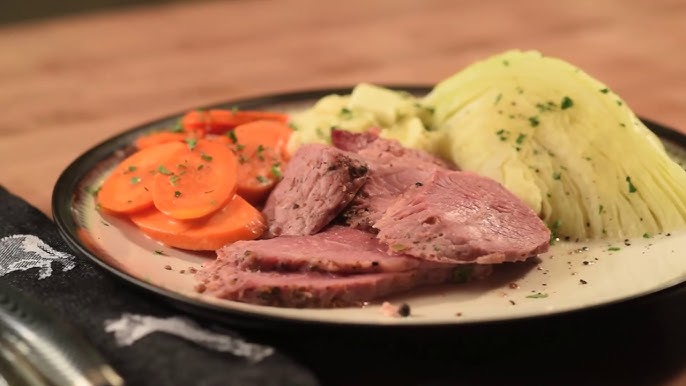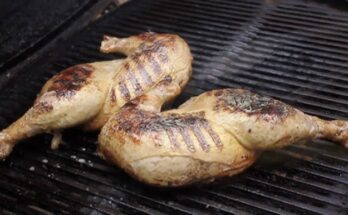Corned Beef Brisket Recipe: If you’ve ever savored a tender, flavorful slice of corned beef brisket and wondered how to recreate that delicious magic at home, you’re in for a treat.
This step-by-step guide will walk you through everything you need to know to prepare a mouthwatering corned beef brisket from scratch. Whether you’re making it for a festive occasion like St. Patrick’s Day or just want to indulge in some hearty, homemade comfort food, this guide will get you there with ease.
Introduction to Corned Beef Brisket
Corned beef brisket is a salt-cured cut of beef, typically taken from the brisket, which is a tough, flavorful cut located near the cow’s chest. This meat, when cured properly and cooked slowly, transforms into a tender and juicy delight packed with bold, savory flavors.
The term “corned” comes from the old English word for small grains, referring to the coarse grains of salt originally used to cure the meat. It became especially popular in Irish-American cuisine and is a beloved staple in delis, especially when served with cabbage or stacked high on rye bread in a Reuben sandwich.
What sets homemade corned beef apart from the store-bought versions is the depth of flavor and the ability to control every ingredient that goes into the process. Plus, there’s a certain joy in saying, “Yep, I made that from scratch!”
Ingredients You’ll Need
Before we dive into brining and cooking, let’s talk about the essentials. A great corned beef brisket starts with quality ingredients. Here’s what you’ll need:
Main Ingredients:
- 4 to 5 pounds of beef brisket (flat cut preferred)
- 1 gallon of water
- 1 cup kosher salt
- 1/2 cup brown sugar
- 1 tablespoon pink curing salt (Prague Powder #1) – optional but recommended for color and safety
- 2 tablespoons pickling spice (homemade or store-bought)
- 4 cloves garlic, crushed
Optional Add-ins for Extra Flavor:
- 2 bay leaves
- 1 cinnamon stick
- 10 black peppercorns
- 6 whole cloves
- 1 teaspoon mustard seeds
- Crushed red pepper (for a little heat)
Tips for Selecting Brisket:
- Go for the “flat cut” if you want uniform slices and easier cooking.
- Look for a good balance of meat and fat — a little marbling helps keep things moist.
These ingredients will help you create a brine that not only cures the meat but also infuses it with rich, deep flavors that stand out after cooking. You can adjust the spice levels and ingredients to match your preferences, making it your own signature dish.
Preparing the Brine
The brining process is where the transformation begins. It’s essentially a flavor bath for your brisket, infusing it with savory, spicy, and slightly sweet notes over several days. Here’s how to make it:
Step-by-Step Brine Preparation:
- Heat Your Water: In a large pot, bring half the water (about 2 quarts) to a simmer. This helps dissolve the salt and sugar thoroughly.
- Mix in Spices: Add the kosher salt, brown sugar, and pink curing salt if using. Stir until everything is fully dissolved.
- Add Aromatics: Toss in your pickling spices, garlic, bay leaves, and any other flavor enhancers you’re using.
- Cool It Down: Once the salt and sugar are dissolved and the spices have had a chance to release their oils, remove the brine from the heat. Add the remaining 2 quarts of cold water to cool the mixture quickly.
- Chill the Brine: Refrigerate the brine until it’s completely cold before adding your brisket. Never add raw meat to warm brine, as it can create food safety issues.
This mixture will act as the flavor base and preservative for your brisket. Be sure your pot or brining container is large enough to fully submerge the meat.
Brining the Brisket
Now comes the patience-testing part—brining your brisket for several days. This is the key to getting that classic corned beef flavor and tender texture.
How to Do It Right:
- Submerge the Brisket: Place the brisket in a non-reactive container (like glass or food-safe plastic), and pour the cooled brine over it until it’s fully covered.
- Weigh It Down: Use a plate or a weight to keep the brisket submerged if it floats.
- Refrigerate: Cover the container tightly and place it in the refrigerator. Brine the meat for a minimum of 5 days and up to 7 for deeper flavor.
- Rotate Daily: Flip the brisket once a day to ensure even brining.
- Ready to Cook: After brining, rinse the brisket thoroughly under cold water to remove excess salt. This prevents your final dish from being overly salty.
The meat will have taken on a slightly pinkish hue due to the curing process — this is a good sign that your brine did its job!
Cooking the Corned Beef Brisket
Once the brining is complete, it’s time to cook the brisket to tender perfection. There are several tried-and-true methods, and each brings out different qualities in the meat.
Three Methods to Consider:
1. Stovetop Method:
- Place brisket in a large pot and cover with water.
- Add extra spices or vegetables like onions, carrots, and celery for flavor.
- Bring to a boil, then reduce to a gentle simmer.
- Simmer for 3 to 4 hours, or until fork-tender.
2. Oven-Baked Method:
- Preheat oven to 300°F (150°C).
- Place rinsed brisket in a roasting pan with a bit of water or broth.
- Cover tightly with foil.
- Bake for 3.5 to 4 hours.
3. Slow Cooker Method:
- Place brisket in the crockpot with enough water to just cover.
- Add seasonings and vegetables if desired.
- Cook on low for 8–10 hours.
After cooking, always let the meat rest for about 10–15 minutes before slicing against the grain. This keeps the brisket juicy and easy to chew.
Serving Suggestions and Pairings
Corned beef brisket is a hearty dish that pairs wonderfully with a variety of sides and beverages. Here are some classic and creative ways to serve your corned beef:
Classic Pairings:
- Cabbage and Potatoes: A traditional pairing, especially for St. Patrick’s Day celebrations. Boil or steam cabbage wedges and serve alongside boiled or mashed potatoes.
- Carrots and Parsnips: Roasted or boiled, these root vegetables add a sweet and earthy flavor that complements the savory brisket.
- Irish Soda Bread: This dense, slightly sweet bread is perfect for sopping up the flavorful juices from the corned beef.
Creative Twists:
- Reuben Sandwich: Layer sliced corned beef with Swiss cheese, sauerkraut, and Russian dressing between slices of rye bread. Grill until the bread is crispy and the cheese is melted.
- Corned Beef Hash: Dice leftover corned beef and sauté with potatoes, onions, and bell peppers for a hearty breakfast or brunch dish.
- Corned Beef Tacos: For a fusion twist, serve shredded corned beef in soft tortillas with cabbage slaw and a tangy mustard sauce.
Beverage Pairings:
- Beer: A cold pint of Irish stout or a malty amber ale complements the rich flavors of corned beef.
- Red Wine: A medium-bodied red wine, such as a Pinot Noir or Merlot, pairs well with the savory meat.
- Non-Alcoholic: Sparkling apple cider or a robust iced tea can be refreshing accompaniments.
Tips for Perfect Corned Beef Brisket
Achieving the perfect corned beef brisket involves attention to detail and a few insider tips:
1. Choose the Right Cut:
- Flat Cut: Leaner and more uniform in shape, making it ideal for slicing.
- Point Cut: More marbled with fat, resulting in a juicier and more flavorful brisket.
2. Rinse Before Cooking:
- Rinse the brisket under cold water to remove excess salt from the brining process. This helps prevent an overly salty final product.
3. Low and Slow Cooking:
- Whether you’re boiling, baking, or slow-cooking, maintain a low temperature to break down the tough connective tissues and achieve tender meat.
4. Slice Against the Grain:
- After cooking, let the brisket rest for 10-15 minutes. Then, slice against the grain to ensure tender, easy-to-chew pieces.
5. Store Properly:
- Leftover corned beef can be stored in an airtight container in the refrigerator for up to 4 days. For longer storage, wrap tightly and freeze for up to 2 months.
Common Mistakes to Avoid
Even seasoned cooks can encounter pitfalls when preparing corned beef brisket. Here are common mistakes and how to avoid them:
1. Skipping the Rinse:
- Not rinsing the brisket before cooking can result in an overly salty dish. Always rinse under cold water to remove surface brine.
2. Cooking at High Temperatures:
- High heat can cause the meat to become tough and dry. Stick to low and slow cooking methods to ensure tenderness.
3. Not Using Enough Liquid:
- When boiling or slow-cooking, ensure the brisket is fully submerged in liquid to prevent drying out.
4. Overcooking Vegetables:
- Add vegetables like cabbage, carrots, and potatoes during the last hour of cooking to prevent them from becoming mushy.
5. Slicing with the Grain:
- Slicing along the grain results in chewy meat. Always slice against the grain for optimal tenderness.
Storing and Reheating Leftovers
Proper storage and reheating techniques can help maintain the quality of your corned beef brisket:
Storing:
- Refrigeration: Place leftover slices in an airtight container with a bit of cooking liquid to keep them moist. Store in the refrigerator for up to 4 days.
- Freezing: Wrap slices tightly in plastic wrap and aluminum foil, or place in a freezer-safe bag. Freeze for up to 2 months.
Reheating:
- Oven: Place slices in a baking dish with a splash of broth or water. Cover with foil and heat at 325°F (163°C) until warmed through.
- Stovetop: Simmer slices in a skillet with a bit of liquid over low heat until heated.
- Microwave: Place slices in a microwave-safe dish with a tablespoon of water. Cover and heat on medium power, checking every 30 seconds.
Variations and Regional Twists
Corned beef brisket has inspired numerous variations across different cultures and regions:
1. Montreal-Style Smoked Meat:
- Originating from Jewish delis in Montreal, this version involves curing the brisket with spices like cracked peppercorns and coriander, then smoking and steaming it. It’s typically served on rye bread with mustard.
2. Pastrami:
- Similar to corned beef, pastrami is cured with a spice mix, smoked, and then steamed. It’s often seasoned with garlic, coriander, black pepper, and paprika.
3. Corned Beef and Cabbage (New England Boiled Dinner):
- A traditional Irish-American dish where corned beef is simmered with cabbage, potatoes, and carrots, often served during St. Patrick’s Day celebrations.
4. Filipino Corned Beef:
- In the Philippines, corned beef is often sautéed with onions and garlic, sometimes with potatoes, and served with rice for breakfast.
Making Homemade Pickling Spice
If you’re the DIY type, making your own pickling spice adds a personal touch and allows for customization. Here’s a basic recipe to get you started:
Homemade Pickling Spice Ingredients:
- 1 tbsp mustard seeds
- 1 tbsp coriander seeds
- 1 tbsp black peppercorns
- 1 tbsp allspice berries
- 1 tsp crushed red pepper flakes
- 1 cinnamon stick (crushed)
- 4 bay leaves (crumbled)
- 6 whole cloves
- 1 tsp ground ginger
- 1 tsp cardamom pods (optional)
Instructions:
- Toast the seeds and spices lightly in a dry pan to release their oils.
- Mix all ingredients and store in an airtight jar.
- Use 2 tablespoons per brine batch.
This blend not only works great for corned beef but can also be used in other pickling recipes and marinades.
Corned Beef Brisket Around the World
Corned beef isn’t just an Irish-American staple—it’s found in various forms across the globe:
Ireland:
Contrary to popular belief, corned beef isn’t a traditional Irish dish. In Ireland, pork was historically more common. However, Irish immigrants in America found beef more accessible and adapted their recipes.
United Kingdom:
Often served cold and sliced, British corned beef (called “bully beef”) is more similar to the canned version and is popular in sandwiches.
Jamaica:
Corned beef (often canned) is sautéed with onions, tomatoes, and Scotch bonnet peppers and served with rice, breadfruit, or dumplings.
Philippines:
Served primarily for breakfast, Filipino corned beef is often sautéed with garlic, onions, and sometimes potatoes, and paired with garlic fried rice and eggs.
FAQs about Corned Beef Brisket Recipe
Q1: What is corned beef brisket?
Corned beef brisket is a cut of beef—typically the flat or point cut of the brisket—that has been salt-cured in a seasoned brine. The “corned” part refers to the large grains of salt historically used in the curing process.
Q2: How long does it take to cook corned beef brisket?
It usually takes about 2.5 to 3 hours to simmer corned beef brisket until tender. If you’re using a slow cooker, it may take 8–10 hours on low or 4–5 hours on high. Always check that it’s fork-tender before serving.
Q3: Should I rinse corned beef before cooking?
Yes, it’s recommended to rinse corned beef under cold water before cooking to remove excess surface salt. This step helps balance the saltiness of the final dish.
Q4: Can I bake corned beef instead of boiling it?
Absolutely! Baking is a popular method. Wrap it in foil and bake at 325°F (163°C) for about 2.5 hours. You can also add vegetables and glaze it for extra flavor.
Q5: What’s the best way to slice corned beef?
Slice corned beef against the grain to ensure tender, easy-to-chew pieces. This means cutting perpendicular to the visible muscle fibers in the meat.
Q6: What sides go well with corned beef brisket?
Classic sides include cabbage, carrots, potatoes, and Irish soda bread. You can also serve it with roasted veggies, coleslaw, or mustard on the side.
Q7: Can I freeze cooked corned beef brisket?
Yes, you can freeze leftover cooked corned beef for up to 2–3 months. Let it cool completely, wrap tightly in plastic wrap and foil, and store in an airtight container.
Q8: Is corned beef brisket the same as pastrami?
Not quite. While both start with brisket, pastrami is usually smoked after curing, whereas corned beef is typically boiled or braised. Pastrami also uses different seasonings.
Q9: What’s the difference between point cut and flat cut brisket?
Flat cut is leaner and slices more evenly, making it ideal for presentation. Point cut is fattier and juicier, which some people find more flavorful.
Q10: How do I know when corned beef is done?
Corned beef is ready when it reaches an internal temperature of 195°F–205°F (90°C–96°C) and can be easily pierced with a fork. Let it rest before slicing for best results.
Conclusion
Corned beef brisket isn’t just a meal—it’s a celebration of flavor, tradition, and patience. Whether you’re cooking for a special holiday or simply satisfying a craving for something savory and soulful, this step-by-step guide equips you with everything you need to master this classic dish.
From selecting the right cut to brining with care, slow-cooking it to perfection, and pairing it with delicious sides, corned beef brisket is a rewarding culinary adventure. Try out different cooking methods, experiment with sides, or explore global variations to make this dish truly your own.



